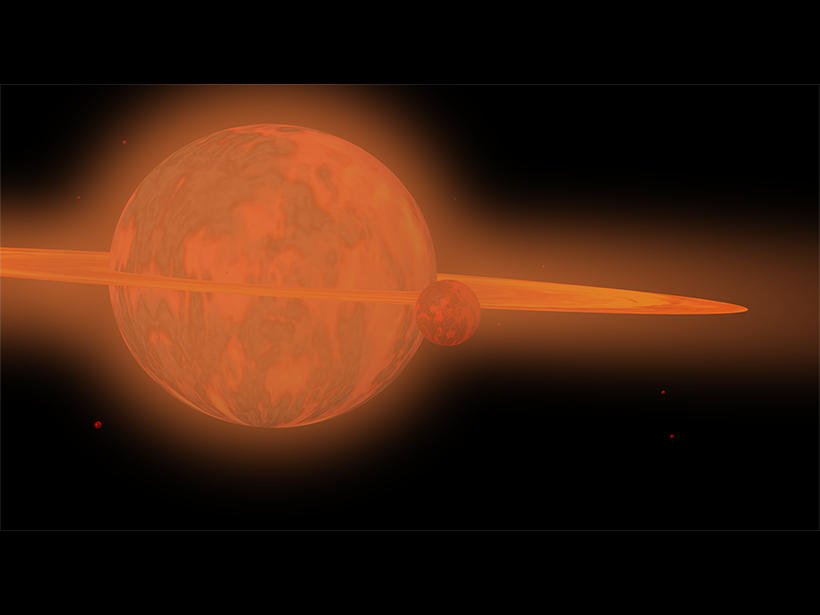The Moon was once thought to lack water inside and out, but new data show that water is present on its surface and in its interior. Water and other volatile chemical compounds containing hydrogen and oxygen leave various clues to their presence, where they came from, how they formed, and what happens to them. Learning to recognize these clues provides insight into the origin and evolution of the Moon and other airless bodies.
The NASA Solar System Exploration Research Virtual Institute (SSERVI) consists of a set of competitively selected teams comprising members from different institutions. Each team has a distinct focus within the science and exploration of the Moon, near-Earth asteroids, and the moons of Mars.
To spur collaboration and progress among the teams, SSERVI convened the Lunar Volatiles Workshop last November at the Johns Hopkins University Applied Physics Laboratory. For 2.5 days, 40 SSERVI team experts and nonteam members participated in focused discussions about common interests across teams that could lead to significant progress in the understanding of lunar volatiles.
Participants discussed previously unappreciated links between volatile materials under the Moon’s surface, at its surface, and at its poles.
Participants at the workshop discussed previously unappreciated links between volatile materials under the Moon’s surface, at its surface, and at its poles. The discussion showcased the diversity of water sources and complexity of transport and retention processes.
This diversity of water sources may explain the striking spatial variation of water and other volatiles, attendees noted. For example, water and other compounds with oxygen-hydrogen bonds adhere to materials on the Moon’s surface. Other volatiles left over from lunar formation are found in glassy pyroclastic deposits, in trace minerals in basalts, and in more evolved lunar igneous rocks. Concentrations of water ice and other frozen volatiles are thermally trapped in permanently shadowed regions near the lunar poles.
Workshop participants agreed that solar wind is probably a present-day source of the hydrogen needed to form hydroxyl ions and that micrometeorites might provide the impulsive energy and local temperature spikes needed to produce water. Lunar volcanism may have been an important source of volatiles as far back as ancient times, speakers noted.
In addition to the many sources of lunar water, workshop participants discussed other key issues, including the following:
- [pullquote float=”right”]The discovery of magmatic “water” forced scientists to recognize the potentially heterogeneous spatial distribution of hydrogen in the lunar mantle.[/pullquote]The paradigm shift that followed the discovery of magmatic “water” in diverse samples from the Moon. This discovery forced scientists to recognize the potentially heterogeneous spatial distribution of hydrogen, and possibly hydrated species, in the lunar mantle.
- The interpretation of observations of water on the extreme surface (the topmost 100 micrometers of material) of the Moon. A spectroscopic signature associated with a hydroxyl layer on the lunar surface is evident, but the observation of a broadband water signature at midlatitude surfaces was not uniquely established.
- Active research that explains the heterogeneity of lunar polar volatiles. A combination of processes including thermal drivers, the efficiency of transport of these volatiles to the poles through the lunar exosphere, and how these volatiles are lost from polar cold traps affects the concentration of polar volatiles.
The authors acknowledge contributions from Robin Canup, Southwest Research Institute; Anthony Colaprete, NASA Ames Research Center; William M. Farrell, NASA Goddard Space Flight Center; Erik Hauri, Carnegie Institution of Washington; Paul G. Lucey, University of Hawaii; Yang Liu, Jet Propulsion Laboratory; Rachel Klima, Applied Physics Laboratory, Johns Hopkins University; and Thomas M. Orlando, Georgia Institute of Technology.
—Dana M. Hurley (email: [email protected]), Applied Physics Laboratory, Johns Hopkins University, Laurel, Md.; Yvonne Pendleton, NASA Ames Research Center, Mountain View, Calif.; and Ariel Deutsch, Brown University, Providence, R.I.
Citation:
Hurley, D. M.,Pendleton, Y., and Deutsch, A. (2017), Signs of water in a moon rock, Eos, 98, https://doi.org/10.1029/2017EO077313. Published on 13 July 2017.
Text © 2017. The authors. CC BY 3.0
Except where otherwise noted, images are subject to copyright. Any reuse without express permission from the copyright owner is prohibited.

